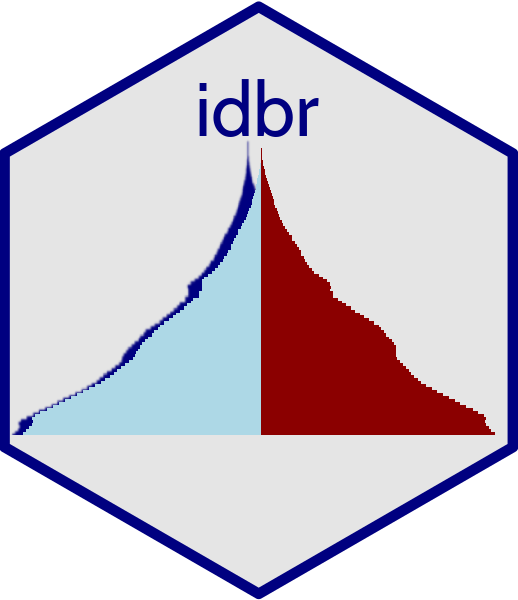
An R interface to the US Census Bureau International Data Base API

Update: version 1.0 introduces a re-written and re-factored package API. Functions from earlier versions of the package are deprecated and not recommended for use.
This R package enables users to fetch international demographic indicators from the US Census Bureau’s International Data Base API and return R data frames. Total population data are available from 1950-2100 (projected); age-group subsets and other demographic indicators are available for varying periods by country.
Install from CRAN with:
install.packages('idbr')Or get the development version from GitHub:
library(devtools)
install_github('walkerke/idbr')To get started, load idbr and set your Census API
key with the idb_api_key() function. An API key can be
obtained from the US Census Bureau at http://api.census.gov/data/key_signup.html. tidycensus
users can use their existing API keys which idbr will pick up if already
installed.
library(idbr)
idb_api_key('Your API key goes here')The core function used in idbr is get_idb(). This
function grants access to two core APIs. The first is the
single-year-of-age API, which returns population counts by single-year
age bands, subsetted optionally by sex and age range. This dataset is
well-suited for analyses and visualizations of the age composition of
countries, such as population pyramids:
library(idbr)
library(tidyverse)
china_data <- get_idb(
country = "China",
year = 2021,
age = 0:100,
sex = c("male", "female")
)
china_data %>%
mutate(pop = ifelse(sex == "Male", pop * -1, pop)) %>%
ggplot(aes(x = pop, y = as.factor(age), fill = sex)) +
geom_col(width = 1) +
theme_minimal(base_size = 15) +
scale_x_continuous(labels = function(x) paste0(abs(x / 1000000), "m")) +
scale_y_discrete(breaks = scales::pretty_breaks(n = 10)) +
scale_fill_manual(values = c("red", "gold")) +
labs(title = "Population structure of China in 2021",
x = "Population",
y = "Age",
fill = "")

get_idb() also grants access to the five-year-age-band
dataset, which includes a wide range of fertility, mortality, and
migration indicators along with overall population counts. In turn, it
can be used to inform analyses of how demographic indicators vary by
country, among many other use cases. The argument
geometry = TRUE can be used to return country boundaries as
simple features along with your data which is helpful for mapping global
and regional trends.
library(idbr)
library(tidyverse)
lex <- get_idb(
country = "all",
year = 2021,
variables = c("name", "e0"),
geometry = TRUE
)
ggplot(lex, aes(fill = e0)) +
theme_bw() +
geom_sf() +
coord_sf(crs = 'ESRI:54030') +
scale_fill_viridis_c() +
labs(fill = "Life expectancy \nat birth (2021)")